Britannia Rules the Waves
For
Turner, there was no more potent symbol of national pride than the magnificent
sailing ships he saw daily on the Thames. They conjured up a world of heroism,
adventure and discovery.
Turner's
lifetime coincided with the golden age of sail. He witnessed not only Nelson's
famous victory at Trafalgar, but also a massive expansion of sea trade with
North America, the West Indies, and the Far East the building of an Empire.
Closer to home, the small coastal and river traders that plied British waters,
delivering passengers and cargo to inaccessible villages all over the country,
were essential for a nation with no effective road or railway system. At the
end of his life, Turner was to see the advent of the steam engine and feel a
mixture of emotions excited by their power, but saddened by the eclipse of the
great sailing ships.
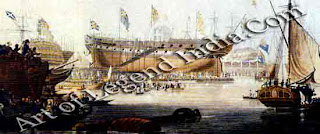 From
his youth in Covent Garden, Turner lived close to the centre of English
commercial shipping. Every day, the Port of London bulged with river traffic.
And with the expansion of British maritime might, London's docks were so
overcrowded that organized pilfering and smuggling became a way of life.
Between July and October the Legal Quays in the Pool of London built in the
15th century were piled eight hogsheads high with sugar, coffee and rum,
presenting an open invitation to the criminal underworld of London's dockland.
From
his youth in Covent Garden, Turner lived close to the centre of English
commercial shipping. Every day, the Port of London bulged with river traffic.
And with the expansion of British maritime might, London's docks were so
overcrowded that organized pilfering and smuggling became a way of life.
Between July and October the Legal Quays in the Pool of London built in the
15th century were piled eight hogsheads high with sugar, coffee and rum,
presenting an open invitation to the criminal underworld of London's dockland.
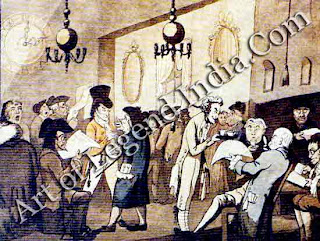
The
building of new docks, with impounded water and surrounded by high fences to
prevent theft, gave new impetus to maritime commerce in the Port of London.
This development, permitted by an Act of Parliament in 1799, was first
under-taken by the West India Company on the loop of the Thames at the Isle of
Dogs which was, at the time, open country. From the opening of the East India
Docks in 1804-6 the Company, which was run along military lines, enjoyed a
monopoly over trade with the West Indies for over two decades. Likewise, its
bitter rival, the London Dock Company, whose quays at Wapping were opened in
1805, enjoyed a monopoly in the handling of tobacco, wine, rice, brandy and
valuable goods from all parts of the world except the West Indies.
THE SLAVE TRADE
While
the bulk of Britain's maritime business in the late 18th century was conducted
with other European countries, many greedy merchants were engaged in the
'Triangular Trade' which connected Britain with the Guinea Coast in Africa and
the British West Indies across the Atlantic. Slaves were purchased in Africa,
in exchange for metal goods, woven materials, guns and trinkets, then sold to
plantation owners in the West Indies, where the boats were loaded with sugar
and molasses for the return trip to England.
The
slaves were manacled for the journey and stowed tightly on shelves only 30 inches
apart. Three out of eight either committed suicide or died of 'the white flux'
and had to be thrown overboard. While seamen in this lucrative but monstrous
business tended to be, as one captain wrote in 1830, 'the very dregs of the
community', those engaged in commerce with India and China enjoyed a more
respectable and exotic reputation.
The
East India Company, which had dealt exclusively with the Orient since 1601,
bringing silks and tea back to Europe, established a reputation for good crew conditions
and an excellence in de-sign and construction of the ships it chartered. The
East Indiamen large ships of 400 to 500 tons, sometimes armed with more than 30
guns were repaired and fitted out in the Brunswick Dock. By 1820, there were
several of more than twice that size. Because of their enviable reputation,
competition for jobs and berths on these ships was intense.
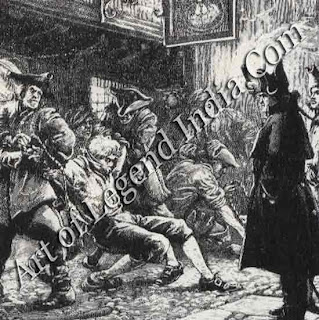 While
shipping business, ranging from whaling in Greenland to orange running from the
Azores, flourished at Lloyd's underwriters in the City of London, the Royal
Navy had to expand rapidly to protect the territorial interests exploited by
the merchants. Every lawful seafarer came to fear the 'press'. Gangs of
officers and well-built ratings armed with a warrant 'for the impressments of
men' were dispatched into waterfront taverns to kidnap able-bodied fellows.
Whalers, with their reputation for ruggedness and dependability, were favourite
targets, while East India crews tended to enjoy a certain privileged immunity.
Nevertheless, merchant ships, particularly during periods of war, often went to
sea under-manned as a result of press-gang raids.
While
shipping business, ranging from whaling in Greenland to orange running from the
Azores, flourished at Lloyd's underwriters in the City of London, the Royal
Navy had to expand rapidly to protect the territorial interests exploited by
the merchants. Every lawful seafarer came to fear the 'press'. Gangs of
officers and well-built ratings armed with a warrant 'for the impressments of
men' were dispatched into waterfront taverns to kidnap able-bodied fellows.
Whalers, with their reputation for ruggedness and dependability, were favourite
targets, while East India crews tended to enjoy a certain privileged immunity.
Nevertheless, merchant ships, particularly during periods of war, often went to
sea under-manned as a result of press-gang raids.
PIRACY ON THE HIGH SEAS
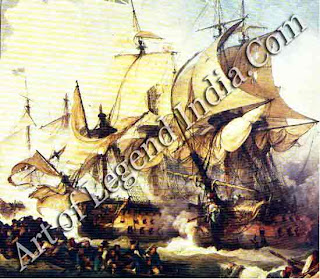 Privateers
or pirates also represented a direct threat to international traders. It was
quite common for a commission, or 'letters of marque' to be issued by a state
to private vessels, licencing them to plunder merchant shipping of foreign
countries. The French, Dutch, Americans and English all engaged in this
practice and not only were the privateers allowed keeping the spoils of their
plundering, but bonuses were paid by governments for each foreign sailor killed
or taken. This led to ships sailing in convoy and increasing their firepower
for protection.
Privateers
or pirates also represented a direct threat to international traders. It was
quite common for a commission, or 'letters of marque' to be issued by a state
to private vessels, licencing them to plunder merchant shipping of foreign
countries. The French, Dutch, Americans and English all engaged in this
practice and not only were the privateers allowed keeping the spoils of their
plundering, but bonuses were paid by governments for each foreign sailor killed
or taken. This led to ships sailing in convoy and increasing their firepower
for protection.
The
design and construction of British war-ships, ranging from First Rates such as
Nelson's Victory, with up to 120 guns, down to Sixth Rates with 20 guns was
much the same as their merchant counterparts although their crews were usually
larger and occasionally included women in the sick-bays for tending the wounded.
Likewise, while they remained three-masted and square-rigged with mainly oak
woodwork, canvas sails and hemp ropes, they continued to grow in size in the
19th century. The major development in de-sign was seen after 1804 when round
shaped bows and sterns replaced the weaker and much more vulnerable square
bulkhead.
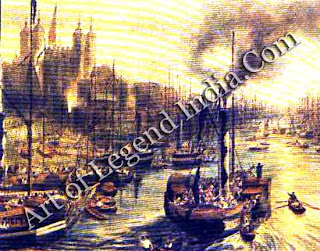
In
later life, when Turner settled in his Thames-side cottage at Cheyne Walk,
Chelsea, he could observe a wide variety of small craft plying the g. river.
The most common boat by far was the smack, a one-masted work-horse which, for
river work, had its bowsprit removed to achieve greater manoeuvrability. Common
on the Thames also was the ranging in size from 12 to 50 tons, which
like the smack carried salt, stone, coal and farm produce along the rivers and
around the shallow coastline. The hoys provided a busy ferry service up and
down the Thames and the seaman's call 'Ahoy' is believed to have originated
from passengers hailing these craft from the river bank.
The first steamboat
appeared on the Thames in 1814 and was an immediate success. Thirteen years
later another steamship crossed the Atlantic for the first time, completing the
journey from Rotterdam to the West Indies in one month. These key events
heralded a battle between sail and steam which continued throughout the
century.
SAIL GIVES WAY TO STEAM
Ironically,
the fierce competition from steam-powered ships, whose speed in adverse weather
gave them a great advantage, inspired sailing ship builders to produce their
finest vessels, such as the famous speedy frigates from the Blackwall Yard in
London, which carried 50 guns and a boudoir for first-class female passengers.
The passing of the leisurely lndiaman was followed by an American innovation in
the form of the clipper whose racy lines helped outlawed slavers, opium traders
and pirates evade capture for several decades, until steamships caught up with
them.
Turner
died in 1851, with the great Yankee clipper perhaps the finest sailing ship
ever in ascendancy. But the commercial lifespan of the ocean-going clipper was
to be short-lived, just as the improvements in roads and the growth of
rail-ways in Britain were rapidly leaving sail-powered smacks and hoys high and
dry.
Writer
– Marshall Cavendish
 From
his youth in Covent Garden, Turner lived close to the centre of English
commercial shipping. Every day, the Port of London bulged with river traffic.
And with the expansion of British maritime might, London's docks were so
overcrowded that organized pilfering and smuggling became a way of life.
Between July and October the Legal Quays in the Pool of London built in the
15th century were piled eight hogsheads high with sugar, coffee and rum,
presenting an open invitation to the criminal underworld of London's dockland.
From
his youth in Covent Garden, Turner lived close to the centre of English
commercial shipping. Every day, the Port of London bulged with river traffic.
And with the expansion of British maritime might, London's docks were so
overcrowded that organized pilfering and smuggling became a way of life.
Between July and October the Legal Quays in the Pool of London built in the
15th century were piled eight hogsheads high with sugar, coffee and rum,
presenting an open invitation to the criminal underworld of London's dockland.  While
shipping business, ranging from whaling in Greenland to orange running from the
Azores, flourished at Lloyd's underwriters in the City of London, the Royal
Navy had to expand rapidly to protect the territorial interests exploited by
the merchants. Every lawful seafarer came to fear the 'press'. Gangs of
officers and well-built ratings armed with a warrant 'for the impressments of
men' were dispatched into waterfront taverns to kidnap able-bodied fellows.
Whalers, with their reputation for ruggedness and dependability, were favourite
targets, while East India crews tended to enjoy a certain privileged immunity.
Nevertheless, merchant ships, particularly during periods of war, often went to
sea under-manned as a result of press-gang raids.
While
shipping business, ranging from whaling in Greenland to orange running from the
Azores, flourished at Lloyd's underwriters in the City of London, the Royal
Navy had to expand rapidly to protect the territorial interests exploited by
the merchants. Every lawful seafarer came to fear the 'press'. Gangs of
officers and well-built ratings armed with a warrant 'for the impressments of
men' were dispatched into waterfront taverns to kidnap able-bodied fellows.
Whalers, with their reputation for ruggedness and dependability, were favourite
targets, while East India crews tended to enjoy a certain privileged immunity.
Nevertheless, merchant ships, particularly during periods of war, often went to
sea under-manned as a result of press-gang raids. Privateers
or pirates also represented a direct threat to international traders. It was
quite common for a commission, or 'letters of marque' to be issued by a state
to private vessels, licencing them to plunder merchant shipping of foreign
countries. The French, Dutch, Americans and English all engaged in this
practice and not only were the privateers allowed keeping the spoils of their
plundering, but bonuses were paid by governments for each foreign sailor killed
or taken. This led to ships sailing in convoy and increasing their firepower
for protection.
Privateers
or pirates also represented a direct threat to international traders. It was
quite common for a commission, or 'letters of marque' to be issued by a state
to private vessels, licencing them to plunder merchant shipping of foreign
countries. The French, Dutch, Americans and English all engaged in this
practice and not only were the privateers allowed keeping the spoils of their
plundering, but bonuses were paid by governments for each foreign sailor killed
or taken. This led to ships sailing in convoy and increasing their firepower
for protection. 


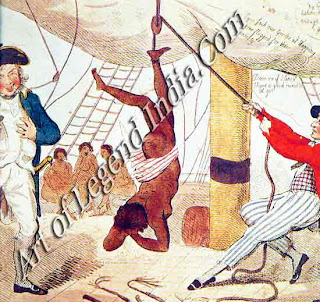











Very good website, thank you.
Paper Mache Radha Krishna Wall Hanging
Order Handicrafts Products
Handicrafts Products Online